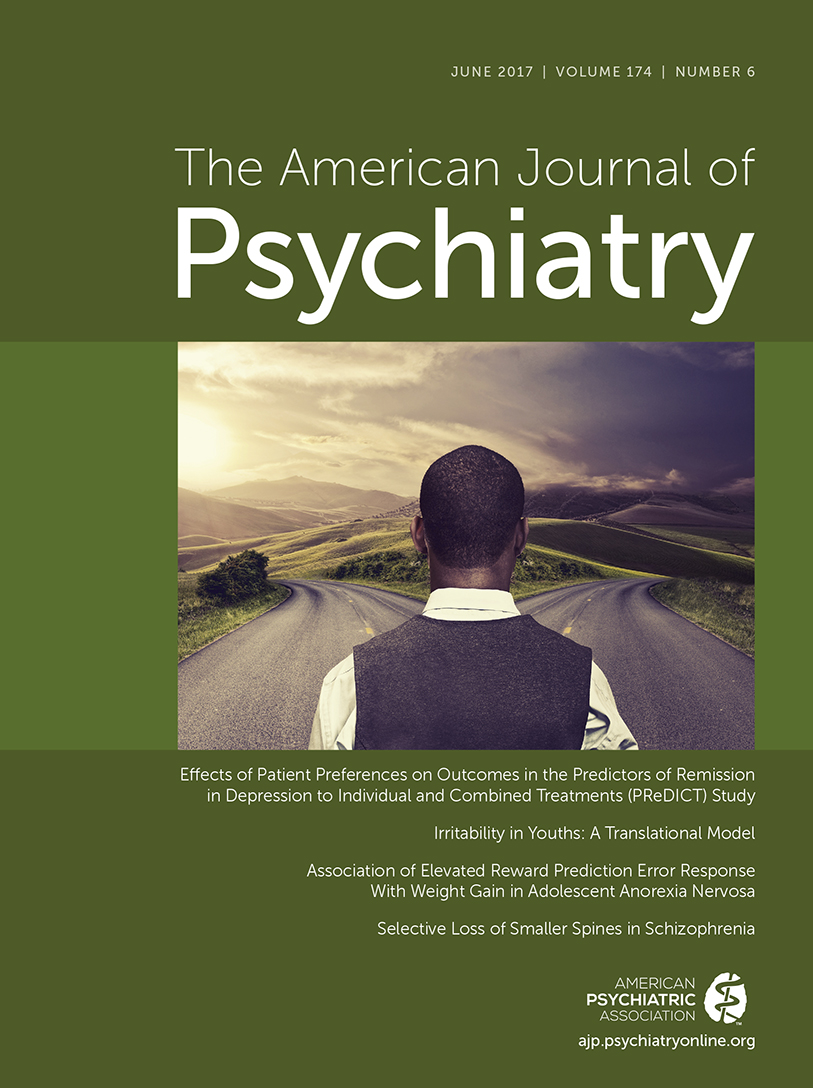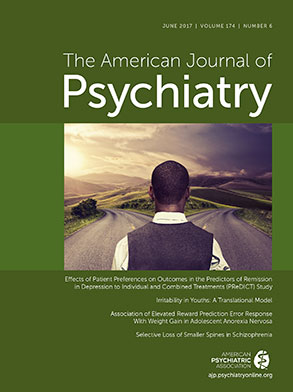To the Editor: We thank McKay and colleagues for their comments, in which they expressed their concerns about the minimum effect size at which one may declare imaging results to be substantively, specifically, and causally related to putative psychopathological states. It is certainly important for the field to be aware of the extent of progress in brain imaging research in psychiatry and of key limitations that must be addressed.
The first issue concerns the extent of structural changes seen in psychiatric disorders in general and in obsessive-compulsive disorder (OCD) in particular. OCD imaging studies have been performed using relatively small sample sizes, with inaccurate effect sizes in any particular study (
1). With meta- and mega-analyses, we can put these results in context and better estimate true effect sizes. Admittedly, any abnormalities may remain subtle, and structural MRI provides only a crude and indirect measure of putative alterations at the molecular level. Nevertheless, small volumetric abnormalities can have profound effects on behavior. Indeed, Cohen’s (
2) rules of thumb (suggesting an effect size of 0.20 is “small,” 0.50 is “medium,” and 0.80 is “large”) fail to address the point that even a very small effect size can help in understanding the pathophysiology of a disorder. Thus, single-nucleotide polymorphisms in genome-wide association studies may explain a very small percentage of trait variance but may still have robust effects, and in aggregate they may account for a substantial fraction of disease risk (
3). For example,
APOE and
TREM2 genotypes explain only a small fraction of overall disease risk but are targets of major efforts in Alzheimer’s disease research and are being used to stratify patients in clinical trials (
4). Similarly, subtle yet reproducible evidence for structural abnormalities in the hippocampal complex (where d equals approximately 0.4–0.5) has given rise to several models of hippocampal dysfunction in schizophrenia (
5), which are supported by postmortem and animal studies of cellular and molecular mechanisms (
6). Therefore, we do not advocate cutoffs as to which effect sizes should be reported. If effect sizes are not “censored,” future meta-analyses and even literature searches will be less affected by reporting bias.
A second issue concerns the specificity of structural changes in brain imaging studies. McKay et al. argue that the thalamus abnormality we reported in pediatric OCD is not disease specific. It is becoming increasingly clear that mental disorders share genetic risk factors, and so not surprisingly, there is overlap in the brain circuits involved. There is value, however, in investigating the extent to which neurocircuitry overlaps across disorders or differentiates between conditions, and in determining the extent to which these overlaps and distinctions are from shared or specific genetic and environmental effects. Notably, results of very large-scale analyses by other working groups of the Enhancing NeuroImaging Genetics Through Meta-Analysis (ENIGMA) consortium, such as studies of schizophrenia (
5), bipolar disorder (
7), major depressive disorder (
8), attention deficit hyperactivity disorder (
9), and autism spectrum disorder (unpublished 2017 study of D. van Rooij et al.), do not show thalamus abnormalities in their patient groups. This thalamus abnormality thus seems somewhat specific to children with OCD. The main group comparison also showed a larger pallidum and smaller hippocampus in adult OCD patients. However, ENIGMA data suggest that reduced hippocampal volume may not be disease specific. The ENIGMA consortium is well positioned to investigate the consistency and specificity of neural correlates of neuropsychiatric disorders in its ongoing work.
A third issue is causality. We agree with McKay et al. that we do not yet know if the brain abnormalities we have reported are the cause or consequence of the disorder or if they have a common cause. Nevertheless, taken together, a broad range of basic and clinical work has certainly provided mechanistic insights into how specific brain regions may contribute to OCD. Furthermore, the emerging picture from imaging and from genetics is that in psychiatry there are often multiple intersecting causes (
10), some specific to a disorder and others not. Longitudinal twin studies of concordant and discordant cases are needed to disentangle genetic and environmental modulators of causes and consequences of disease. The larger pallidum in adult OCD appears to be driven by patients with an early disease onset, suggesting that this pallidum effect may be related to many years of repetitive behavior. This finding is repeatedly found in the literature and, despite its small effect size, is highly consistent with models of OCD. Large-scale studies such as ours are well powered to distinguish consistent, generalizable findings from false positives and so contribute to the consolidation of causal hypotheses. While the subcortical structures evaluated in this work do not yet encompass the entirety of brain structural networks and functions, the data provide important insight into what systems are more affected in OCD and promote further research to evaluate specific pathways implicated in the causes and consequences of this condition.

